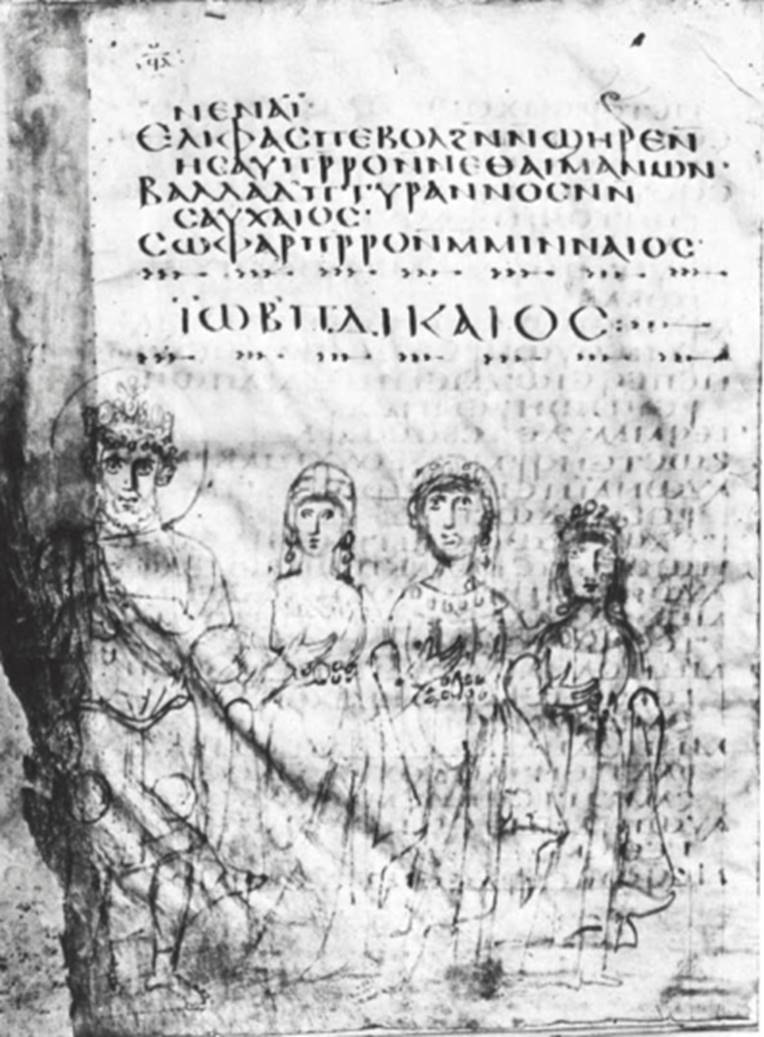Drawing of Job and his family represented as Heraclius and his family. Egypt, about 615-640. Parchment
Brush drawing on one sheet of fragmentary Old Testament, written in Sahidic Coptic dialect in uncial Coptic script. The eight folios begin with Job 40:8 and end at Prov. 3:19; the drawing is on fol. 4v, the last page of Job, below the end title. The script had been dated in the seventh to ninth century (cf. Delbrueck, 1929, p. 272), but recently it has been suggested it could be as early as the fifth (Rome, 1954).
Portrayed is a male figure standing to the right of three females, all in imperial costume. The emperor wears an ornate diadem, with a halo behind his head. He wears a belted tunic with chlamys fastened at right shoulder with a brooch, high boots on his feet, lance in the right hand, and globus in the left. His hair protrudes under his crown, and he has a short full beard. The ladies wear long-sleeved tunics under elaborate dalmatics, with jeweled girdles; all have earrings, but the forms of their crowns differ, with the second one on emperor's left wearing that of an empress. The girlish figure on extreme left may be wearing a crown of flowers. Two women in center have spherical coiffures held by snoods, indicating their married state; princess at left still wears her hair long and free.

Ainalov (1961) first suggested that, since Job is not identified as royal in the biblical text, this could be a portrayal of an imperial household; Delbrueck (1929) showed, by comparison of regalia, that the only likely subjects were Heraclius, his second wife Martina (m. 614), his sister/ mother-in-law Epiphania, and his daughter Eudoxia (b. 611). Kurz (1942-1943), however, pointed out that the Coptic text included a final chapter of Job, found in the Septuagint but not in the Vulgate or other European Bible texts: in this chapter it is said that Job's name was originally Jobab, and that he was the King of Edom mentioned in Genesis 36:33. Hence, the illustration is in fact pertinent to its location, at the conclusion of that terminal chapter of the book.
Still, the illustration is derived from a contemporary imperial “icon": the Coptic monk who added this picture to the manuscript symbolized his biblical king in terms of his own ruler. In the Cyprus silver plates, conversely, Heraclius is symbolized by the Old Testament King David (nos. 425-433). Even as the heroic feats of David prefigured the youthful conquests of Heraclius, the Coptic artist may well have known of the terrible trials the same emperor underwent later in life—largely due to foreign invasions, but also in the public unpopularity due to his incestuous second marriage. The choice of Heraclius to represent Job may have been more than just fortuitous.
The manuscript was no. 25 in the Museo Borgiano at Velletri, one of a large group of Coptic manuscripts from the White Cloister at Sohag, in Upper Egypt, purchased by Cardinal Cesare Borgia late in the eighteenth century. The entire collection was acquired early in the next century by the Biblioteca Borbonica, now Biblioteca Nazionale, of Naples.
Bibliography: Delbrueck, 1929, pp. 270-274; Kurz, 1942-1943; Rome, 1954, no. 1; Ainalov, 1961, pp. 66—68, 287-288; Leroy, 1974, pp. 181-184, pi. 111.
Date added: 2025-07-10; views: 151;
